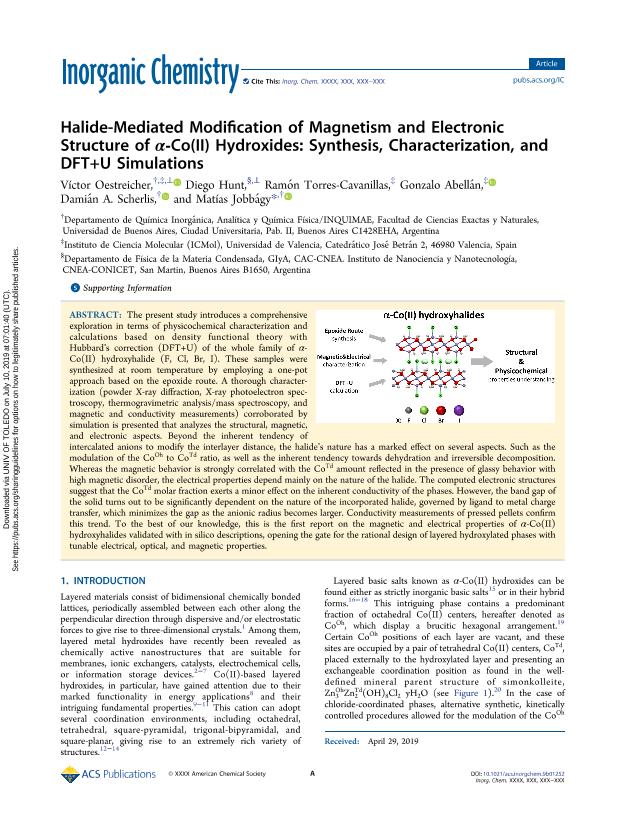Mostrar el registro sencillo del ítem
dc.contributor.author
Oestreicher, Víctor Santiago Jesús

dc.contributor.author
Hunt, Diego

dc.contributor.author
Torres Cavanillas, Ramon
dc.contributor.author
Abellan, Gonzalo
dc.contributor.author
Scherlis Perel, Damian Ariel

dc.contributor.author
Jobbagy, Matias

dc.date.available
2021-01-25T15:47:07Z
dc.date.issued
2019-07
dc.identifier.citation
Oestreicher, Víctor Santiago Jesús; Hunt, Diego; Torres Cavanillas, Ramon; Abellan, Gonzalo; Scherlis Perel, Damian Ariel; et al.; Halide-Mediated Modification of Magnetism and Electronic Structure of α-Co(II) Hydroxides: Synthesis, Characterization, and DFT+U Simulations; American Chemical Society; Inorganic Chemistry; 58; 14; 7-2019; 9414-9424
dc.identifier.issn
0020-1669
dc.identifier.uri
http://hdl.handle.net/11336/123593
dc.description.abstract
The present study introduces a comprehensive exploration in terms of physicochemical characterization and calculations based on density functional theory with Hubbard's correction (DFT+U) of the whole family of α-Co(II) hydroxyhalide (F, Cl, Br, I). These samples were synthesized at room temperature by employing a one-pot approach based on the epoxide route. A thorough characterization (powder X-ray diffraction, X-ray photoelectron spectroscopy, thermogravimetric analysis/mass spectroscopy, and magnetic and conductivity measurements) corroborated by simulation is presented that analyzes the structural, magnetic, and electronic aspects. Beyond the inherent tendency of intercalated anions to modify the interlayer distance, the halide's nature has a marked effect on several aspects. Such as the modulation of the CoOh to CoTd ratio, as well as the inherent tendency towards dehydration and irreversible decomposition. Whereas the magnetic behavior is strongly correlated with the CoTd amount reflected in the presence of glassy behavior with high magnetic disorder, the electrical properties depend mainly on the nature of the halide. The computed electronic structures suggest that the CoTd molar fraction exerts a minor effect on the inherent conductivity of the phases. However, the band gap of the solid turns out to be significantly dependent on the nature of the incorporated halide, governed by ligand to metal charge transfer, which minimizes the gap as the anionic radius becomes larger. Conductivity measurements of pressed pellets confirm this trend. To the best of our knowledge, this is the first report on the magnetic and electrical properties of α-Co(II) hydroxyhalides validated with in silico descriptions, opening the gate for the rational design of layered hydroxylated phases with tunable electrical, optical, and magnetic properties.
dc.format
application/pdf
dc.language.iso
eng
dc.publisher
American Chemical Society

dc.rights
info:eu-repo/semantics/openAccess
dc.rights.uri
https://creativecommons.org/licenses/by-nc-sa/2.5/ar/
dc.subject
layered hydroxides
dc.subject
cobalt
dc.subject
magnetism
dc.subject
epoxide route
dc.subject.classification
Química Inorgánica y Nuclear

dc.subject.classification
Ciencias Químicas

dc.subject.classification
CIENCIAS NATURALES Y EXACTAS

dc.title
Halide-Mediated Modification of Magnetism and Electronic Structure of α-Co(II) Hydroxides: Synthesis, Characterization, and DFT+U Simulations
dc.type
info:eu-repo/semantics/article
dc.type
info:ar-repo/semantics/artículo
dc.type
info:eu-repo/semantics/publishedVersion
dc.date.updated
2020-11-20T14:49:14Z
dc.journal.volume
58
dc.journal.number
14
dc.journal.pagination
9414-9424
dc.journal.pais
Estados Unidos

dc.journal.ciudad
Washington
dc.description.fil
Fil: Oestreicher, Víctor Santiago Jesús. Consejo Nacional de Investigaciones Científicas y Técnicas. Oficina de Coordinación Administrativa Ciudad Universitaria. Instituto de Química, Física de los Materiales, Medioambiente y Energía. Universidad de Buenos Aires. Facultad de Ciencias Exactas y Naturales. Instituto de Química, Física de los Materiales, Medioambiente y Energía; Argentina
dc.description.fil
Fil: Hunt, Diego. Consejo Nacional de Investigaciones Científicas y Técnicas. Oficina de Coordinación Administrativa Ciudad Universitaria. Unidad Ejecutora Instituto de Nanociencia y Nanotecnología. Unidad Ejecutora Instituto de Nanociencia y Nanotecnología - Nodo Bariloche | Comisión Nacional de Energía Atómica. Unidad Ejecutora Instituto de Nanociencia y Nanotecnología. Unidad Ejecutora Instituto de Nanociencia y Nanotecnología - Nodo Bariloche; Argentina
dc.description.fil
Fil: Torres Cavanillas, Ramon. Universidad de Valencia; España
dc.description.fil
Fil: Abellan, Gonzalo. Universidad de Valencia; España
dc.description.fil
Fil: Scherlis Perel, Damian Ariel. Consejo Nacional de Investigaciones Científicas y Técnicas. Oficina de Coordinación Administrativa Ciudad Universitaria. Instituto de Química, Física de los Materiales, Medioambiente y Energía. Universidad de Buenos Aires. Facultad de Ciencias Exactas y Naturales. Instituto de Química, Física de los Materiales, Medioambiente y Energía; Argentina
dc.description.fil
Fil: Jobbagy, Matias. Consejo Nacional de Investigaciones Científicas y Técnicas. Oficina de Coordinación Administrativa Ciudad Universitaria. Instituto de Química, Física de los Materiales, Medioambiente y Energía. Universidad de Buenos Aires. Facultad de Ciencias Exactas y Naturales. Instituto de Química, Física de los Materiales, Medioambiente y Energía; Argentina
dc.journal.title
Inorganic Chemistry

dc.relation.alternativeid
info:eu-repo/semantics/altIdentifier/url/http://pubs.acs.org/doi/10.1021/acs.inorgchem.9b01252
dc.relation.alternativeid
info:eu-repo/semantics/altIdentifier/doi/http://dx.doi.org/10.1021/acs.inorgchem.9b01252
Archivos asociados
